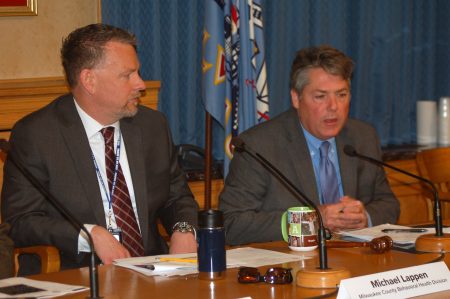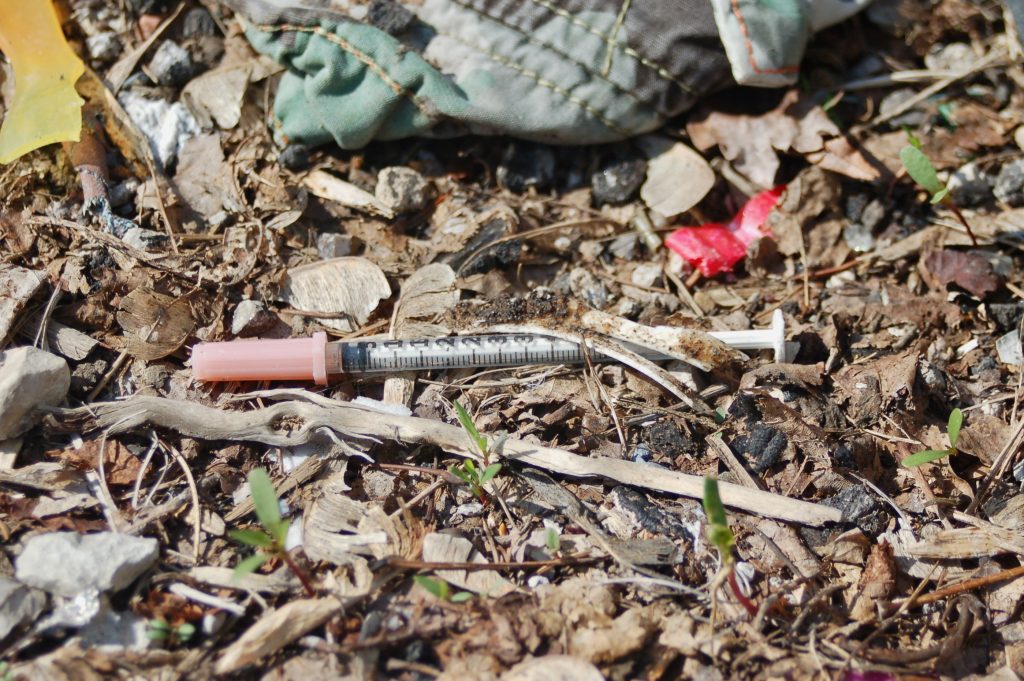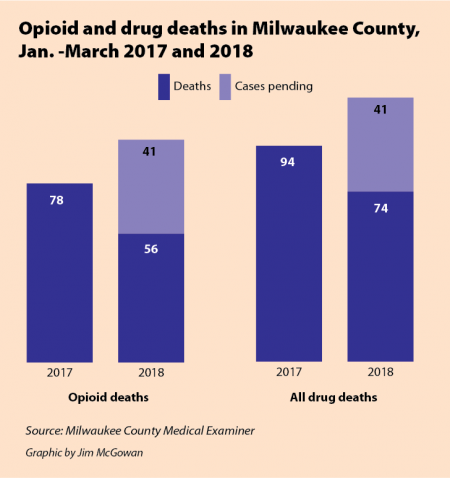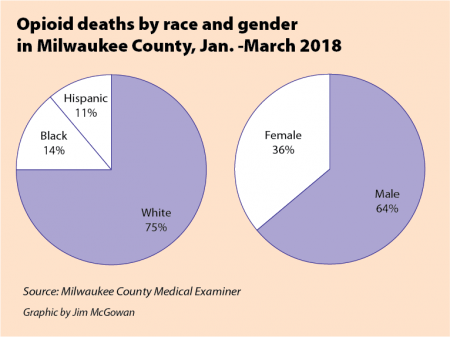City-County Plan Targets Opioid Epidemic
300 opioid overdoses in county last year. Task force proposes eight focus areas.
Carianne Ramanio, 42, is three months pregnant and nine months clean from heroin. Her addiction journey began at 19, she said, as she went from cocaine, to legally prescribed pain pills, to pills bought on the street and eventually heroin.
“I overdosed a couple times. I almost lost my hand due to an infection. I’m done with it,” said the determined grandmother of three who’s spent the majority of her life on Milwaukee’s South Side.
Ramanio, who was revived after her overdoses by Narcan, a drug that reverses the effects of opioids, said she’s lucky to be alive. Others weren’t as fortunate. There were more than 400 drug overdose deaths in Milwaukee County in 2017, more than 300 of which involved opioids. Through the first three months of 2018, 56 opioid-related deaths occurred. That number will rise. Determinations still need to be made on 41 additional toxicology cases, according to Karen Domagalski, operations manager for the Milwaukee County Medical Examiner’s Office. Last year there were 78 opioid-related deaths in the county from January through March.
The pace of drug overdose deaths in 2018, including six that occurred during the weekend of May 12 and 13, is similar to last year, according to the medical examiner’s office. Two of the recent six deaths occurred in the 53204 ZIP code on the South Side, which is where the highest number of opioid overdose victims through the first three months of 2018 resided. Increases in drug activity and prostitution, which is strongly connected to the opioid epidemic, have contributed to a rash of seven homicides that have occurred within a 20-block radius in 53204 since March. Several of the murders remain unsolved.
As the deaths accumulate, a preliminary plan to reduce fatal overdoses of opioids and other drugs has been released by the City-County Heroin, Opioid, and Cocaine Task Force.
The plan consists of eight focus areas including: enhancing and funding existing prevention programs; reducing the number of drug violation arrests; improving epidemiology and surveillance; developing programs in collaboration with the criminal justice system; and supporting federal, state and local policies and legislation. The plan was originally scheduled to be finalized by February, Bevan Baker told Milwaukee Neighborhood News Service in a December interview. At the time Baker was the task force chairman and commissioner of the Milwaukee Health Department (MHD). Baker resigned in January amid an avalanche of criticism over his handling of the city’s lead poisoning crisis.
Baker’s departure, along with that of Hector Colon, the first task force chairman, and overall disarray within MHD, delayed the release of the comprehensive plan, acknowledged Ald. Michael Murphy, co-chair of the task force with Michael Lappen, administrator of the Behavioral Health Division (BHD) for Milwaukee County. The group also had difficulty gathering a quorum and scheduling meetings since it was created in February 2017.
“There are certain things I can’t control and others I can,” Murphy said.
Despite those difficulties and the daunting challenge of slowing the pace of drug deaths in the county, Murphy said he is confident that the partnerships and collaborations created through the group, which are now part of the comprehensive plan, will have an impact.

Michael Lappen (left), administrator of the Behavioral Health Division (BHD) for Milwaukee County, and Ald. Michael Murphy are co-chairs of the City-County Heroin, Opioid, and Cocaine Task Force. Photo by Edgar Mendez.
“I think in the past people worked in their own silos and what the task force tried to do is recognize that with limited financial resources we need to support each other. We’ve broken down some of those borders,” Murphy said.
Ongoing efforts that have been strengthened through the task force include increases in funding specific to the opioid epidemic, more locations to dispose of prescription pills, increased distribution of needles, and more access to and training to administer Narcan, Murphy said.
Also in the works is a collaboration with Medical College of Wisconsin (MCW), which will provide recommendations to the task force on best practices or promising approaches to treat those who are addicted to opioids and other drugs, Murphy said. A social media campaign to help reduce the stigma associated with opioid addiction and to try to prevent young people from becoming users also is being planned, he added.
Another aspect of the plan will be to target individuals who recently overdosed, according to Lappen.
“The idea is to follow up within 24 hours and tell them, ‘Hey, you just almost died. What can we do to help you?’” Lappen said.
That effort, which is also a collaboration with MCW, will include hiring people with lived experience with opioid addiction, he said. The program will be supported through a $250,000 grant awarded by the Wisconsin Department of Health Services (DHS) to Milwaukee County to expand treatment for opioid addiction.
According to data included in the task force’s preliminary plan, 75 percent of individuals with substance use disorders never receive treatment. In addition, 70 percent of the state’s prisoners have a substance abuse problem, with only 10 percent receiving treatment while incarcerated, according to estimates by the Wisconsin Department of Corrections. Lappen said it is important for the plan to take a public-health approach and treat addiction as the disease that it is, rather than focusing on the issue through a law enforcement lens.
“There will be a number of collaborations to make sure people are getting treatment instead of being criminalized,” Lappen said.
While the plan released by the task force holds promise, said “Tina,” a 35-year-old woman who is battling an opioid addiction, nothing will change until treatment is more readily available in the central city. Although she said she’s no longer taking the opioid pills she spent the last decade addicted to, she now she waits in line each morning for her daily dose at the methadone clinic.
“It’s like I switched from one addiction to another,” she said.
Tina, who requested not to be identified by name, has gone back and forth between suboxone, a drug that blocks the effects of opioids but is also addictive, and methadone, because they are the main treatments available, she said. She remains at risk for going back to pills because once the physical pain that accompanies the withdrawal goes away, individuals are left with the residual damage from their addiction.
That burden, coupled with difficulties in getting a job due to a criminal record, leads many to go back to heroin or other drugs, she said. “Without coping skills to help you get adjusted to your new life, it’s a lost cause.”
Ramanio has remained drug free since August, after taking methadone and suboxone for seven days while detoxing in jail, she said. Prior to that, she’d gone through inpatient and outpatient treatment. Sitting in jail and reflecting on the fact that she is a grandmother, and that she had thrown decades of her life away, helped her finally quit, she said.
“I had to sit down and look at myself. It’s not a good look for a 42-year-old grandmother to be on heroin,” she said.
She also moved from Milwaukee in October, which has helped, she added.
Ramanio said she might make her way back to the city someday, hopefully to start a rehabilitation program for women getting out of prison. Her goal would be to help them find housing and connect with companies that would give them jobs.
“I want to give them a chance to enter back into a society where they feel good about themselves and are actually progressing in life. I’d like to be a success story for them.”
This story was originally published by Milwaukee Neighborhood News Service, where you can find other stories reporting on eighteen city neighborhoods in Milwaukee.
More about the Opioid Crisis
- Milwaukee County Executive David Crowley Announces Over $9 Million for Initiatives to Combat Opioid Epidemic - County Executive David Crowley - Jul 17th, 2025
- AG Kaul, 45 Other Attorneys General Plan to Join $720 Million Settlement with Eight Opioid Drug Makers - Wisconsin Department of Justice - Jul 14th, 2025
- Attorney General Kaul Announces Consent Judgment with Kroger Over Opioid Crisis - Wisconsin Department of Justice - Mar 21st, 2025
- Baldwin Votes to Strengthen Penalties, Step Up Enforcement Around Deadly Fentanyl - U.S. Sen. Tammy Baldwin - Mar 17th, 2025
- Wisconsin Communities Get Millions From Opioid Settlement as Deaths Decline - Evan Casey - Mar 1st, 2025
- MKE County: County Creates Easy Public Access To Overdose Data - Graham Kilmer - Feb 18th, 2025
- Milwaukee County Executive David Crowley and the Office of Emergency Management Launch New Overdose Dashboard - County Executive David Crowley - Feb 18th, 2025
- Fitzgerald Advances Legislation to Fight Opioid Epidemic - U.S. Rep. Scott Fitzgerald - Feb 6th, 2025
- Milwaukee Is Losing a Generation of Black Men To Drug Crisis - Edgar Mendez and Devin Blake - Jan 31st, 2025
- Milwaukee County’s Overdose Deaths Declined For Second Straight Year - Evan Casey - Jan 27th, 2025
Read more about Opioid Crisis here
Political Contributions Tracker
Displaying political contributions between people mentioned in this story. Learn more.

























A 42-year old GRANDMOTHER of 3 who is also 3-months pregnant and was addicted to drugs from 19 to 41?! OMG! There is no discipline in this household. The spiritual vacuum is a black hole! So many unloved children. How does this plan define a prevention program? The other 7 foci are too late.
@timothy, spiritual black hole? White milwaukee remininces to when south side was full of big, poor polish families, but then turns around and judges big poor latino familes? That’s the spiritual blackhole.
We need to get this poor woman clean, and leave the judgments about family composition behind. Big families are great. I wish milwaukee had more of them, so we could reverse the population declines that are sapping our region’s vitality.
Legalize medical cannabis like 40 other states already have! States with medical cannabis programs have seen a minimum of 25% decrease in opioid deaths and overdoses. Vote Walker and these GOP liars and mooching bums out of office in November. They are blocking reform and thus causing the opioid crisis in Wisconsin to get worse and worse while it abates in other states. Republicans must go in November. We need to change and join the.modern civilized world again, not be some dumb, backwards republican backwater anymore.
Fire Walker. Fire the GOP, legalize cannabis Wisconsin.
I wish Milwaukee had more of them, so we could reverse the population declines that are sapping our region’s vitality.
The article appears to be a propaganda piece designed to assure the reader that something is being done to effectively deal with the increased incidence of opioid related overdoses.
Here is a link to the new version of the plan https://milwaukee.legistar.com/LegislationDetail.aspx?ID=2965576&GUID=0563F682-215F-46EF-B751-663D43F417EC&Options=ID%7CText%7C&Search=161554 and it is very instructional to compare it to the previous version of the plan https://milwaukee.legistar.com/LegislationDetail.aspx?ID=2965576&GUID=0563F682-215F-46EF-B751-663D43F417EC&Options=ID%7CText%7C&Search=161554 see attachment 139 “Work Plan Draft (as of 01-04-18). The previous version of the plan actually had goals, strategies, a work plan, task lists, status on tasks completed etc… But the Task Force has apparently lost its project manager and so now the new plan merely has focus areas — the strategies will be determined, so they say, as a result of public input at three public hearings to be scheduled later this summer.
The article does not accurately restate the subset of the 8 Focus Areas it chose to call out. For example, the article says one of the focus areas is “reducing the number of drug violation arrests” while Focus Area 3 in the report says “Reduce the number of drug violation-related arrests among youth.” Another focus area according to Mr. Mendez is “developing programs in collaboration with the criminal justice system” while the report actually says “Develop programs in collaboration with the criminal justice system that treat addiction as a disease, while actively working to reduce the availability of illicit substances.” Mr Mendez’s restatement of only a subset of the report goals is deceptive by its inaccuracy. Where in the so called new “comprehensive plan” is any goal or strategy outlined that will actually reduce the number of drug violation arrests across ALL affected age groups? What programs exactly is the Task Force working on in collaboration with the criminal justice system? The report itself alludes to treating addiction as a disease and I have written about this fallacious notion here: https://steemit.com/disease/@paulmozina/is-freedom-a-disease
The article mentions “increased distribution of needles” — how and where is this being accomplished? Where does the Task Force mention this?
The article summarizes a point made by Mr. Lappen: “Lappen said it is important for the plan to take a public-health approach and treat addiction as the disease that it is, rather than focusing on the issue through a law enforcement lens.”
A successful “Comprehensive” Plan would include looking at the problem through the law enforcement lens, or silo, and making appropriate adjustments. The Task Force is simply ignoring the law enforcement silo. There is a War On Drugs going on and it is causing more harm than any substance misuse. The cycle of broken homes, especially in minority communities, caused by drug war prosecutions is one of the significant factors that must be considered. Prohibition is the root cause of the overdose problem leading directly to crime, violence and the introduction of extremely dangerous synthetic opioids like fentanyl. The Task Force, like so many government commissions, will not venture into controversial territory., they prefer their safe silos. They even heard testimony from a local DEA supervisor stating that there were “a lot” of doctors illegally prescribing opioids and they did nothing about it — no follow-up with Ms. Federico. I documented this extensively in my article at https://steemit.com/drugwar/@paulmozina/the-unaccountable-dea
Sorry, Here is a link to the new version of the plan https://milwaukee.legistar.com/LegislationDetail.aspx?ID=3489406&GUID=843F651F-D3FA-4E84-ACB6-94A9A830ABB3&Options=ID%7CText%7C&Search=171812 see attachment 17 “Initial Work Plan (Public Version 05-02-18). The first link in my comment above goes to the page with the old version of the plan (attachment 139)